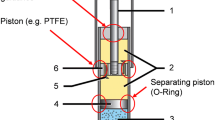Abstract
Shimmy is a phenomenon of intense angular self-excited vibrations of the wheels of a carriage. Such self-excited vibrations present a serious threat to traffic safety, which accounts for the great interest of researchers in this phenomenon. The problem is of highest importance for the front wheels of aircraft. Usually, the deformation of pneumatic tires is considered to be the main factor responsible for shimmy. Without challenging this thesis, we nevertheless note that this is not the only factor. The shimmy phenomenon can be observed in everyday life in the case of various carriages that often have nothing to do with pneumatics if the wheels are rigid. Below we will show that the theory of polycomponent dry friction fully explains the shimmy phenomenon for absolutely rigid wheels and, hence, is at least one of the factors responsible for shimmy in the general case. The reason why researchers have not taken dry friction into account when explaining shimmy is that the theory of this kind of friction has not been well developed; at the same time one has failed to explain shimmy in the framework of other existing theories.
Similar content being viewed by others
References
V. S. Gozdek, “Reaction of the ground on a vibrating rolling wheel with an elastic tire,” Dokl. Akad. Nauk SSSR 186(5), 1031–1033 (1969) [Sov. Phys., Dokl. 14, 536–537 (1969)].
M. V. Keldysh, “Shimmy of the front wheel in three-wheel landing gear,” in Selected Works: Mechanics (Nauka, Moscow, 1985), pp. 491–530 [in Russian].
K. S. Kolesnikov, Self-Oscillations of Steerable Automobile Wheels (Gostekhizdat, Moscow, 1955) [in Russian].
J. Medzorian, “An investigation of landing gear shimmy: tire models, tire test methodologies, analysis and parameter studies,” SAE Tech. Paper 1999-01-5527 (1999), doi: 10.4271/1999-01-5527.
H. B. Pacejka, Tyre and Vehicle Dynamics (Butterworth-Heinemann, Oxford, 2002).
Y. Rocard, Dynamique générale des vibrations (Masson, Paris, 1949).
J. Svendenius, “Tire models for use in braking applications,” Licentiate Thesis (Dept. Autom. Control, Lund Univ., Lund, 2003).
I. G. Goryacheva, Mechanics of Frictional Interaction (Nauka, Moscow, 2001) [in Russian].
V. Ph. Zhuravlev, “On the dry friction model in problems of dynamics of rigid bodies,” Usp. Mekh. 3(3), 58–76 (2005).
V. Ph. Zhuravlev and D. M. Klimov, “On the dynamics of the Thompson top (tippe top) on the plane with real dry friction,” Izv. Ross. Akad. Nauk, Mekh. Tverd. Tela, No. 6, 157–168 (2005) [Mech. Solids 40 (6), 117–127 (2005)].
V. Ph. Zhuravlev and D. M. Klimov, “The causes of the shimmy phenomenon,” Dokl. Akad. Nauk 428(6), 761–764 (2009) [Dokl. Phys. 54, 475–478 (2009)].
Author information
Authors and Affiliations
Additional information
Original Russian Text © V.Ph. Zhuravlev, D.M. Klimov, P.K. Plotnikov, 2013, published in Trudy Matematicheskogo Instituta imeni V.A. Steklova, 2013, Vol. 281, pp. 32–41.
Rights and permissions
About this article
Cite this article
Zhuravlev, V.P., Klimov, D.M. & Plotnikov, P.K. A new shimmy model. Proc. Steklov Inst. Math. 281, 27–36 (2013). https://doi.org/10.1134/S0081543813040044
Received:
Published:
Issue Date:
DOI: https://doi.org/10.1134/S0081543813040044




